The offer is unexpected: “Would you like to swap seats?”
It’s daybreak; we’re flying the notoriously narrow valley into Paro, Bhutan’s only international airport, and the spectacular views of the surrounding Himalayan mountains are difficult to see from my aisle seat. Gratefully, I change positions with the Bhutanese woman who’s seated next to a window, quietly surprised by her generosity.
As it transpires, this simple act of kindness perfectly embodies the Buddhist kingdom’s approach to life.
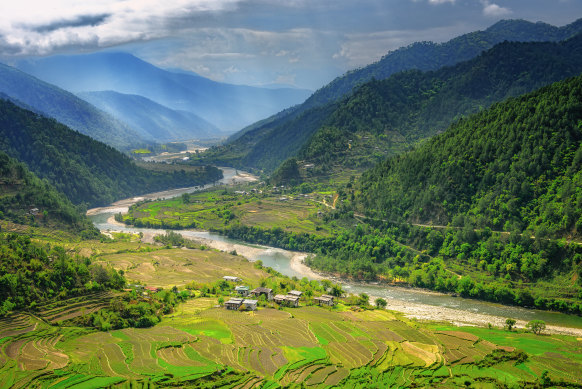
Tourism is relatively new in this pristine country. Credit: istock
Bhutan may not be the world’s happiest country (that ranking is consistently held by northern European countries such as Finland), but there are reasons it’s often perceived as such; the main one being the concept of Gross National Happiness that its fourth ruler, Jigme Singye Wangchuck, introduced back in the 1970s.
His idea was to balance economic development with traditional practices and individual wellbeing. Rather than a vague notion of everyone aiming for personal fulfilment, as is often assumed, it means free education and healthcare, financial support for rural communities and a focus on sustainability (to the extent that Bhutan became the first of only three carbon-negative countries – the others are Suriname and Panama).
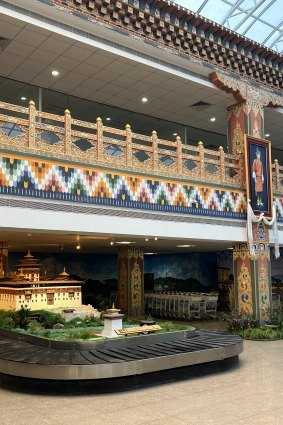
Paro, the world’s most enchanting airport?Credit: Trudi Jenkins
The ethos is reflected in the widespread celebration of nature, community and spirituality – as personified by our gentle guide, Tashi Phuntsho, who gave up a career in engineering to share his homeland with tourists; a job he deems his “calling” and “religion”. Tashi greets us after we’ve cleared security in what must be the world’s most enchanting airport, with its miniature temples at the baggage carousel and its intricately painted immigration counters.
Of winding roads and woven robes
We’re here to experience luxury travel company andBeyond’s first lodge in Asia, in the subtropical former capital, Punakha. It’s a four-hour minibus ride from Paro around winding mountain roads reminiscent of Switzerland (and the car sickness I suffered as a child), even though the driving distance is only 130 kilometres.
Dressed in the traditional woven robe (or gho) worn by guides and officials, Tashi is soon regaling us with stories and legends about this pristine and magical country. There are tales of demons, snake spirits, mythological animals and deities, and explanations of the numerous different buddhas.
He tells us how locals consult astrologers before important decisions, make daily offerings to appease gods and prioritise family and community above all else.
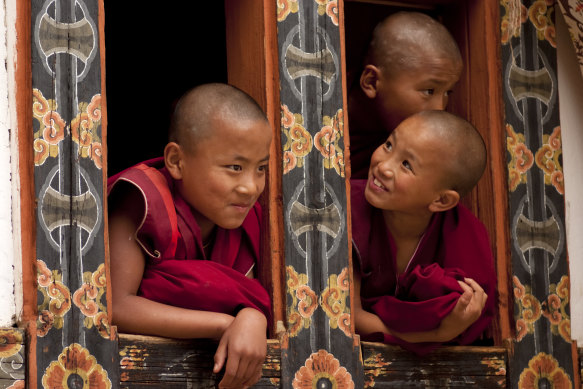
The kingdom of Bhutan is predominantly Buddhist. Credit: istock
Bordered by China to the north and India to the south, Bhutan’s isolated position, lack of tourists, and guidance from the royal family has kept its predominantly Buddhist belief system relatively free from outside influence (television was banned until 1999).
Without wanting to sound like an extra from Eat, Pray, Love, coming from a country where corporate greed, short-term politics and the cult of celebrity dominate, it feels refreshing and inspiring.
(That’s not to say things aren’t changing; mobile phones and social media have infiltrated, like everywhere else, and many Bhutanese have left rural poverty behind in search of jobs and education in cities such as Perth.)
From snowy peaks to frothy cappuccinos
Tashi’s efforts to summarise hundreds of years of history and religion to a group of slightly dazed travellers – we were up at 2am to catch our flight from Bangkok – are interrupted by a stop at the Dochu La pass, not far from the capital, Thimphu.
At 3140 metres, it offers a 180-degree panorama of the snowy Himalayas, including Bhutan’s highest peak, if you’re here on a clear day (more likely during winter). The sense of scale and space inspires wonder and a feeling of insignificance in equal measure.
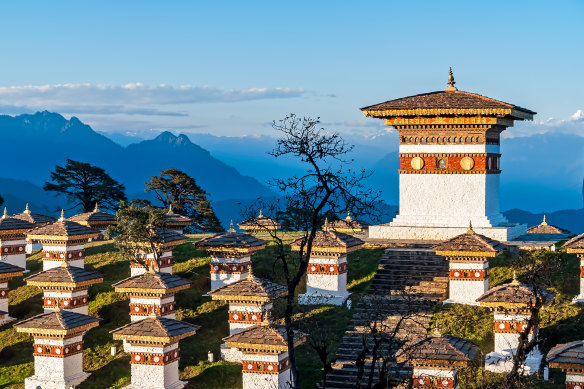
Chortens at Dochula Pass; the Himalayas in the distance can be seen on a clear day.Credit: iStock
We have welcome espresso coffees at the Druk Wangyal Cafe, enjoying its warming wood-fired stove – although the skies are blue, it’s a chilly 6 degrees – then encounter our first chortens on the hillside opposite. Chortens, or stupas, Tashi explains, are religious monuments that symbolise Buddha and many are not as ancient as you might assume.
This supremely photogenic collection of 108 of them was built in 2005 to atone for the loss of Bhutanese life when Indian insurgents were driven out of the country two years earlier.
Equally moving are the white flags we see grouped on hillsides as we drive along; anytime a person dies, friends and relatives each plant a tall wooden pole with a long prayer flag in their memory, a starkly beautiful sight.
We continue our journey down towards Punakha, a fertile valley of rice paddies where the Mo Chhu (Mother River) and Po Chhu (Father River) meet. It’s at a much lower altitude (1240 metres) so there’s no need to worry about altitude sickness, and the weather is warm and sunny even though it’s December (though temperatures drop considerably at night).
Luxury with a conscience in them thar hills
AndBeyond’s Punakha River Lodge, a former royal residence, sits on 50 acres of land, much of which has been given to locals to farm so they can earn an income providing organic vegetables and herbs to the lodge and other nearby hotels. Electricity is generated by hydropower and there are plans to share this with the villagers.
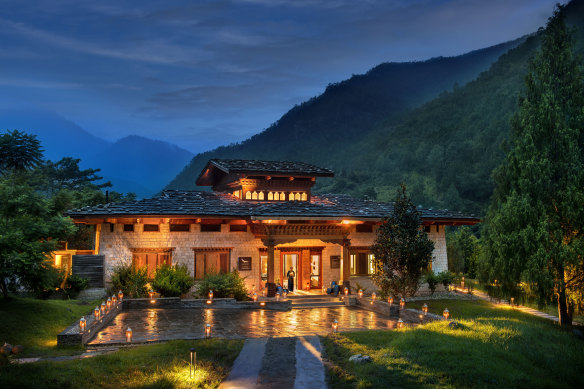
Punakha River Lodge is a former royal residence.
The company’s conservation-led business model revolves around giving back more than they take from their 29 locations in Africa, South America and now Asia; it’s about caring for the land, the wildlife and the people. The philosophy feels seamlessly in sync with everything Tashi has been telling us about Bhutan’s own guiding principles.
The traditional lodge building houses a comfortable lounge area with open bar and coffee machine; a dining room and an interactive outdoor kitchen where we later learn to make momos (cheese or meat dumplings). There’s also a small boutique selling Bhutanese textiles, linen, bags and jewellery that is much-frequented by those on our trip.
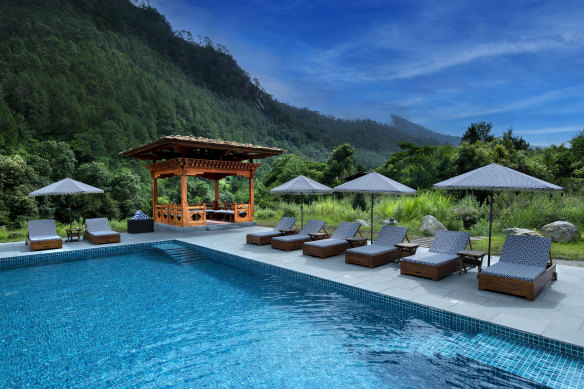
A lush, dramatic backdrop at the outdoor heated pool.
Outside, lushly forested hills and distant mountains are the backdrop for a heated outdoor swimming pool, yoga studio (with free classes at 7.30am each morning) and a walled seating area with fire pit and lanterns. A spa with two treatment rooms has just opened; the traditional hot-stone baths are not quite ready when we visit but it’s certainly the most tranquil setting for a massage that I’ve encountered.
Flagstone paths lead to six tented suites layered with rugs, woollen throws, lamps and bone-inlay furniture from India.
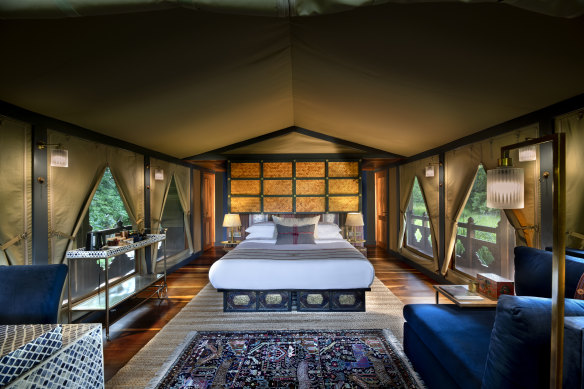
The interiors echo andBeyond’s ethos of decor reflecting the place and culture around it.
The fast-flowing Mo Chhu river rushing past nearby is so loud that on day one I wake in the dead of night, thinking I’ve accidentally left the air-conditioning on high.
The suites have been built far enough away to avoid any potential flooding, but the current is so strong that earlier suggestions of us swimming had been met with consternation. Cocooned under snug blankets, however, it turns out that the cascading water’s white noise is more effective than any sleep app.
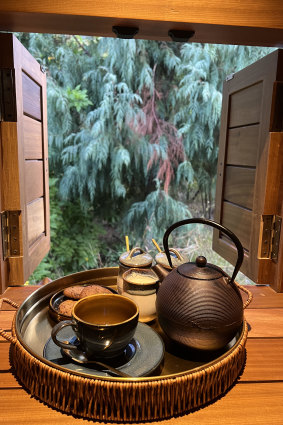
“Bed tea” is served through a wooden hatch every morning.Credit: Trudi Jenkins
Bathing is more peaceful in the generous ensuite bathrooms with central brass-clad tubs, where you’ll find white towels embroidered with a blue poppy, the national flower.
There is also an outdoor shower; wide wooden balcony with sofa, armchairs and table, and my favourite feature – a shuttered window hatch where “bed tea” and homemade biscuits are unobtrusively delivered early each morning by Nira Sharma, our butler.
If only that were something I could introduce back home in Australia.
In addition to the tented accommodation is a one-bedroom villa with plunge pool and a two-bedroom family villa with private swimming pool where a lucky Dutch couple (who have holidayed at all but two of andBeyond’s properties) are staying for nine days.
One of the reasons an extended stay is appealing is that the andBeyond team, led here by general manager Rishi Sarma, pride themselves on creating special moments that enhance your experience of the lodge and its surroundings.
My kind of spirit-uality
Mystery and whispering among the staff precede all our outings, and we soon discover why. After a scheduled afternoon visit to Punakha Dzong, a mesmerising 17th-century fortress that’s now a monastery and deemed the most beautiful building in the country, we return to the minibus for the short drive back to the lodge.
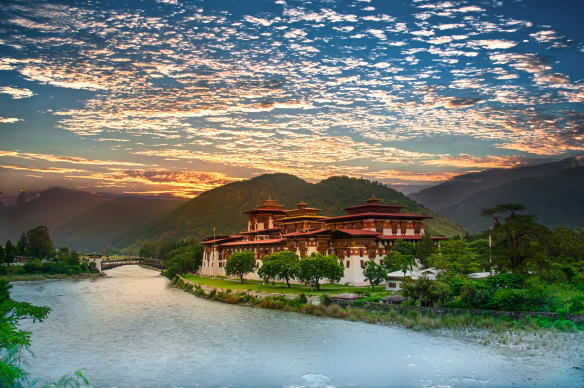
Punakha dzong, a former fortress that’s now a monastery, is renowned as Bhutan’s most beautiful building.Credit: iStock
But our driver, Tshewang, turns off the road and we find ourselves at the river’s edge, looking back at the dzong as the sun starts to slip towards the horizon. Sundowners have been set up on the pebbly beach, with gin, tonic, lime and fresh pomegranate seeds beckoning (I may have made a lame joke about the cocktails being my type of spirit-uality).
Also on offer (despite an earlier three-course lunch at the lodge) is an array of freshly baked mini quiches and pastries – another andBeyond trait we learn to recognise: irresistible food at every turn.
The following day, we meander through a nearby village, noticing (somewhat unexpectedly, it must be said) the large phalluses painted on the exterior of houses and sold as colourful wooden ornaments – traditional symbols of good luck for warding off evil spirits, which are now frowned upon in more urban areas.
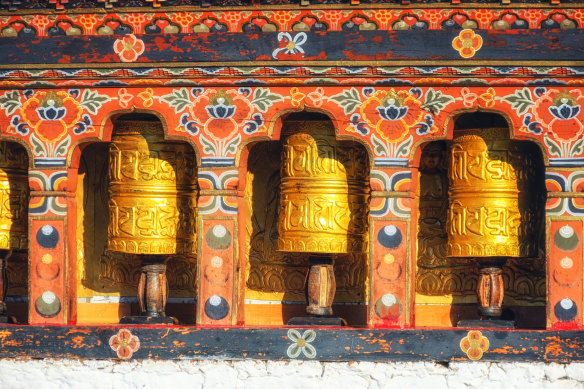
Prayer wheels are found everywhere and spun clockwise for good fortune.Credit: iStock
We pass a prayer wheel surrounded by families whose vibrant clothing makes me feel extremely drab in my all-black hiking gear. The kids pose happily for photographs; tourists are still something of a novelty here and they seem as delighted by our interest as we are by their friendly nature.
It’s a short distance to Chimi Lhakhang or the “Temple of the Divine Madman”, dedicated to a 15th-century lama – a spiritual leader – who apparently taught through bizarre humour and obscene antics. It’s become known as a temple of fertility, and childless couples come here to share gifts (there are piles of bread rolls and, rather incongruously, packets of chips) and be blessed. The current lama shows us a book full of photographs of babies and messages of gratitude from thankful couples.
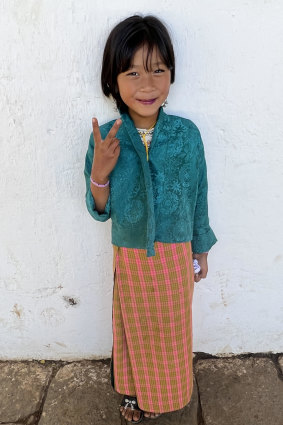
A Bhutanese girl poses happily. Credit: Trudi Jenkins
Back in the minibus, we continue to Sangchhen Dorji Lhuendrup Lhakhang nunnery – a complex that also houses a meditation centre and a school of higher learning. We are invited to light a butter lamp (filled with clarified yak butter or, more likely these days, vegetable oil), to promote inner wisdom.
Much to my fellow travellers’ amusement, however, my ignorance of Buddhist practices remains: during the Tshewang blessing ceremony, I mistake the nuns – with their shaved heads and loose crimson robes – for monks.
After negotiating a broken-down truck that’s blocking the road outside, we arrive at a hilltop clearing where weathered prayer flags are dancing in the breeze. A long table has been set up among the trees, and a succession of tiffin boxes reveals a lunch of baked eggplant, daikon salad, tempura beans and beef tagine as well as a chilli-chocolate mousse, sorbets and fruit.
Any thoughts of an afternoon siesta in our tented suites are quickly relinquished when we return to the lodge to find an outdoor activity waiting. Archery is the national sport in Bhutan, and we learn how to fire a bow and arrow towards (being the operative word in my case) a target. There’s also a game of outdoor darts, at which I’m equally inept, but others nail easily.
Off to the side, another table groans with more food, including a whole cake made by pastry chef Manashi Phookan that, still full to the gills from lunch, we ask be given to the staff.
The surprises continue at dusk. We meet at the fire pit and walk down to the river to find camp chairs, sunset drinks and yet more snacks. That’s all before a traditional Bhutanese dinner in the dining room, where well travelled executive chef, Rudolf van der Westhuizen, introduces a selection of thali to share.
Chillies are so popular here that the country cannot produce enough to meet demand, but van der Westhuizen has made most of the dishes “foreign spicy” to cater for tourist palates, and the spinach soup, buckwheat noodles and jasha maru (chicken stew with ginger) are delicious.
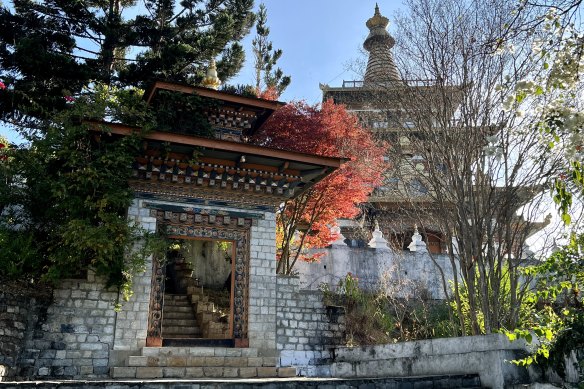
An easy hike leads to the Khamsum Yulley Namgyal Chorten.Credit: Trudi Jenkins
The kindness of strangers
The next morning starts with an early hike to the Khamsum Yulley Namgyal Chorten, built high above the valley in 2004 by the (Bhutanese) Queen Mother. On the lower slopes of the terraced hills we pass farmers under a makeshift shelter tending cows and heating food over an open fire, and as we get higher, there are wild flowers, pine trees reaching for the cloudless sky and the silver river snaking below.
At the summit, the three-storey carved-wood chorten with its golden spire is elaborately decorated, and almost overwhelming in its collection of vivid demonography – it was intended to protect king and country. Outside, the mountain, river and valley views from the 30 metre-high rooftop are glorious. And, unlike at so many other tourist locations around the world, we are completely alone, save for Nira and other lodge staff who have (of course) set up a brunch more suited to the end of a one-day hike than a one-hour one.
Revived by eggs, granola and croissants seemingly conjured from nowhere, we follow the trail back down to a calm section of the river where hardier types dive into the icy water (I compromise with a barefoot paddle). En route, we pass a young girl selling fruit from a box. Having had no luck at the airport ATM, I apologise for not having any cash but she insists I take a piece anyway.
Eventually we reach the swaying suspension bridge that leads back to the lodge grounds and Tashi hands us each a prayer flag to tie on its handrail. It’s coloured blue (sky), white (air), red (fire), green (water) and yellow (earth), to signify balance, which seems helpful as we make our way over the rushing river and our blessings are carried away by the wind.
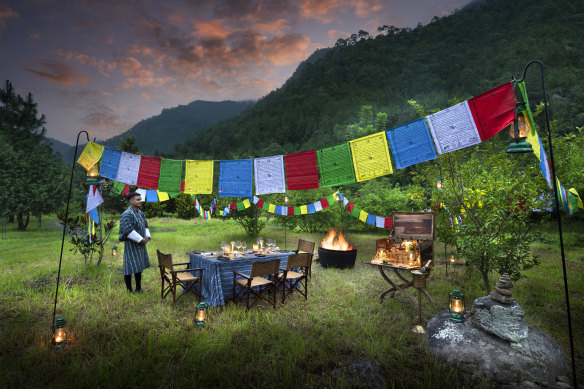
Outdoor dining at Bhutan’s Punakha River Lodge.
After our final night’s boma – an African-style barbecue under the stars that’s integral to andBeyond’s DNA – and a final bed tea the following morning, we reluctantly gather for the journey back to Paro. The staff line up near our minibus and begin to sing a traditional goodbye that is spellbinding; we stand entranced for several minutes, glad that sunglasses hide a couple of tears that materialise without warning. In the end, Rishi interrupts with a laugh: “They won’t stop singing until you get on the bus and leave!”
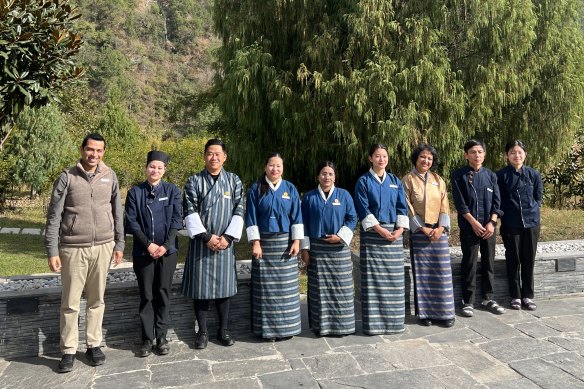
AndBeyond staff line up to sing a traditional farewell.Credit: Trudi Jenkins
Back on the plane a few hours later, I’m again allocated an aisle seat. This time, an Australian who’s visited Bhutan a few times insists I swap to his window seat.
It seems the kindness of strangers is infectious in this intoxicating country.
THE DETAILS
Fly
Qantas flies direct to Bangkok from Sydney daily. Connect from the Thai capital with one of Bhutan’s two national airlines (see panel for more detail).
Overnight in Bangkok at the renowned Como Metropolitan, with its outdoor pool, spa and excellent Nahm restaurant. See qantas.com.au; comohotels.com
Stay
andBeyond will make all arrangements for your travel to Bhutan from Bangkok. Punakha River Lodge tented suites cost from $US1130 ($1720) a night for double occupancy. Rates are fully inclusive (including picnics, sundowners, special meals on property, breakfast at Khamsum Yulley, hikes and cycling). See andbeyond.com
FIVE THINGS TO KNOW BEFORE YOU GO
Planning
Travel to Bhutan is best organised through a tour operator or travel agency who will organise visas, pay the mandatory Sustainable Development Fee ($US100/$150 a day), and take care of guides and transportation (self-drive with car hire is not possible; public transport is limited to buses and you mostly need to be accompanied by a guide anyway).
Logistics
The easiest way to get to Bhutan from Australia is via Bangkok. Bhutan has two airlines (Bhutan Air and Druk Air) and flights into Paro leave very early in the morning to avoid cloud cover later in the day so it’s best to stay in Bangkok the night before. Flights to and from Bhutan often stop briefly in India or Bangladesh so don’t be surprised by a short interruption to your journey.
Money
Credit and debit cards are gradually becoming more widely accepted but even where they are (including at ATMs), we found it difficult to get a transaction to go through. Easier to carry cash (Bhutanese ngultrums or US dollars); use the foreign exchange desk at Paro airport. As tours, entrance fees and accommodation are prepaid, you’ll only need cash for souvenirs and extras such as laundry or drinks, as well as to tip your guide and driver at the end of your trip.
Customs
Always take off your shoes (slip-ons are a good idea) before entering a sacred site and walk in a clockwise direction (including around stupas and prayer wheels).
What to wear
Dress modestly at temples and monasteries (and wear layers as the temperature can vary widely in a day).
The writer travelled as a guest of andBeyond and Como Hotels & Resorts.
Sign up for the Traveller Deals newsletter
Get exclusive travel deals delivered straight to your inbox. Sign up now.